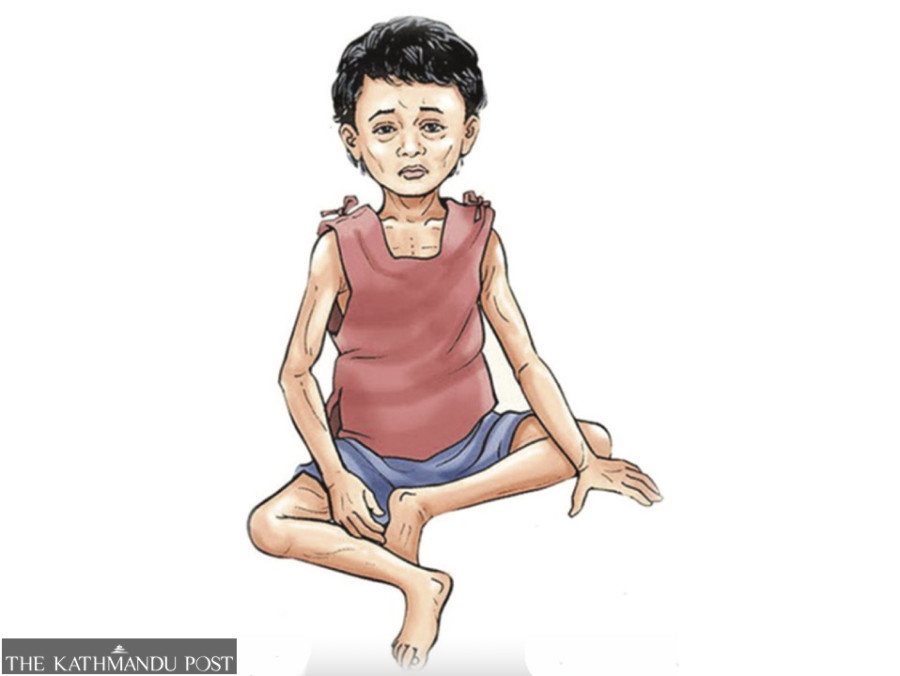Health
Some 30 percent malnourished children deprived of treatment
Lack of food in rural areas and overuse of junk food in urban areas causes of malnutrition.
Arjun Poudel
A few weeks ago, health workers serving at Benighat-Rorang Rural Municipality of Dhading district came across a case of severe child malnourishment. The seven-month-old baby girl weighed just five kg, her height was 61 cm only, and mid-upper arm circumference was just 100 mm.
“All indicators suggest that the child has been suffering from severe acute malnutrition,” Shankar Duwadi, a health worker serving at the rural municipality, told the Post, on the phone from Dhading.
According to Duwadi, the baby, for her age, was underweight as she should have been at least 8.3 kg and 67 cm meters tall, and a mid-upper arm circumference of less than 110 is an indication of severe acute malnutrition. Such children should be immediately referred for treatment, as per the protocol.
Malnutrition is brewing into a silent crisis for Nepal.
Along with the said child, 24 other children under five years old, were found suffering from severe acute malnutrition in the rural municipality.
Health workers serving there had carried out screening of malnourished children in the midst of the pandemic, which helped them identify several malnourished children.
Of the 186 children screened of late in the rural municipality, 25 were diagnosed as severely acute malnourished and 39 others moderately malnourished.
Although malnourished children in Dhading were recommended for treatment, thousands of other such children from across the country have been deprived of treatment as parents of the children refrained from treatment due to fear of Covid-19 infection.
“Parents of around 30 percent malnourished children have been not seeking treatment for their children,” said Lila Bikram Thapa, chief of Nutrition Section at the Family Welfare Division, told the Post. “Problems will exacerbate when malnourished children do not get treatment on time.”
Doctors say severely acute malnourished children need hospital care.
They say problems of malnutrition have been emerging as a major health issue amidst the pandemic and what is concerning is that the parents of the malnourished children are unaware of the problems. Health authorities have shifted their entire focus to the coronavirus.
Nutritionists, as well as officials under the Ministry of Health and Population, say that the ongoing Covid-19 pandemic has worsened the malnutrition problems.
Duwadi, of Benighat-Rorang Rural Municipality, said that children in the district also suffer from seasonal malnutrition (when food becomes scarce for a certain period due to various reasons), which is concerning.
“At this time, the number of children suffering from nutritional deficiency has lessened, and it starts to increase after a few months,” said Duwadi. “We found that the same child got malnourished three to four times in a five-year period.”
Nutritionists say that the problems seen in Dhading could be just a tip of the iceberg.
“In rural areas, children are getting malnourished in lack of sufficient food but in cities it is the excessive consumption of junk food which is causing malnutrition,” said Dr Keshab Bhattarai, a nutrition scientist. “Ensuring sufficient food and launching an awareness campaign against excessive use of junk food could lessen the ongoing problems of nutrition.”
Although people have stopped seeking treatment for malnutrition due to fear of Covid infection, the problem is not new to Nepal. The Multiple Indicator Survey-2019 showed that the problem had worsened long before the start of the pandemic.
The report showed that 12 percent of children under the age of five suffer from wasting. Wasting or low weight for a particular height is an undernutrition condition, which is a strong predictor of mortality among children under five, according to the World Health Organization. Wasting in children, if not treated properly, is associated with a higher risk of death, according to the report.
Only 10 percent of children under five were suffering from wasting in 2016, according to the Nepal Demographic Health Survey-2016. According to the survey, over one million children under five years of age in Nepal are stunted, over 800,000 are underweight and over 300,000 are affected by wasting.
Unlike in the past, nutrition rehabilitation centers have not been repurposed into quarantine centres during the ongoing third wave of the pandemic. Several nutrition rehabilitation homes were shut down in the first and second wave of the pandemic leaving children deprived of treatment.
"Child and infant mortality rates will increase, and our years of efforts and investments to reduce child mortality will be wasted if we are unable to address the problems at the earliest,”said Kedar Parajuli, former chief of nutrition section at the Family Welfare Division under the Department of Health Services.
Experts say a decline in the number of people seeking services for malnutrition problems despite continuation of the services is concerning.
“Nutrition issue is also associated with development issues as it affects overall development of the country,” said Dr Aruna Uprety, a public health expert. “But in our country the problems have been overlooked.”




 17.12°C Kathmandu
17.12°C Kathmandu














